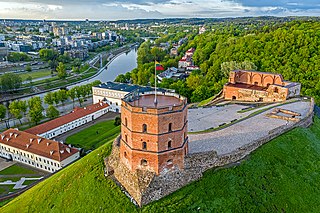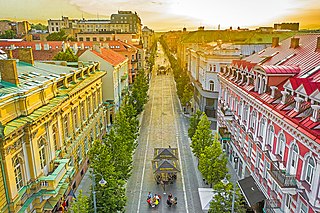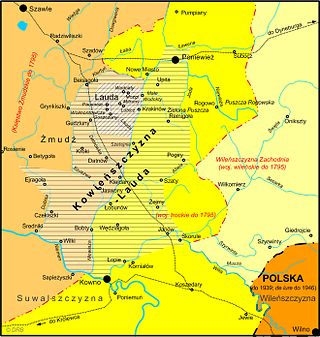
Vilnius, previously known in English as Vilna, is the capital of and largest city in Lithuania and the second-most-populous city in the Baltic states. The city's estimated July 2024 population was 605,270, and the Vilnius urban area has an estimated population of 708,627.

Gediminas' Tower is the remaining part of the Upper Castle on top of the Gediminas Hill in Vilnius, Lithuania. It has a viewing platform that offers scenic views of Vilnius Old Town and Vilnius Central Business District.

The Vilnia is a river in Belarus and Lithuania. Its source is near the villages of Kiemėnai and Vindžiūnai, 6 km south of Šumskas, nearby to the A3–M7 Medininkai–Kamenny Log border crossing complexes of the Belarus–Lithuania border.

Pilėnai was a hill fort in the Grand Duchy of Lithuania. Its location is unknown and is subject to academic debates, but it is well known in the history of Lithuania due to its heroic defense against the Teutonic Order in 1336. Attacked by a large Teutonic force, the fortress, commanded by Duke Margiris, tried in vain to organize a defense against the larger and stronger invader. Losing hope, the defenders decided to burn their property and commit mass suicide to deprive the Order of prisoners and loot. This dramatic episode from the Lithuanian Crusade has caught the public imagination, inspired many works of fiction, and became a symbol of Lithuanian struggles and resistance.

Gediminas Avenue is the main street of Vilnius, where most of the governmental institutions of Lithuania are concentrated, including the government, parliament, Constitutional Court and ministries. It is also the location of cultural institutions such as the Lithuanian National Drama Theatre, Bank of Lithuania, Lithuanian Academy of Music and Theatre and Martynas Mažvydas National Library. It is also a popular shopping and dining street, with the highest average rent prices in the country. It is partially a pedestrian street in the evenings when traffic is prohibited.

The Cathedral Basilica of St Stanislaus and St Ladislaus of Vilnius is the main Catholic cathedral in Lithuania. It is situated in Vilnius Old Town, just off Cathedral Square. Dedicated to the Christian saints Stanislaus and Ladislaus, the church is the heart of Catholic spiritual life in Lithuania.

Rambynas is a hill on the right bank of the Neman River in Rambynas Regional Park, Pagėgiai Municipality, western Lithuania. The current hill, about 46 metres (151 ft) above sea level and about 40 metres (130 ft) above the Neman, is a remnant of the larger hill that was destroyed by erosion. The hill was known as sacred among locals and played a role in the ceremonies of pagan Lithuanians. It is featured in many local legends and is protected by the state as a mythological object. A large stone at the top of the hill, known as the altar stone, was destroyed by a miller in 1811. Rambynas became popular with Prussian Lithuanians at the end of the 19th century who organized various events, most notably celebrations of the Saint Jonas' Festivals or Rasos, on the hill. They rebuilt the altar in 1928. The hill is popular with Lithuanian neo-pagans and hosts the annual celebrations of the summer solstice on 23 June.

The Palace of the Grand Dukes of Lithuania is a palace in Vilnius, Lithuania. It was originally constructed in the 15th century for the rulers of the Grand Duchy of Lithuania and the future Kings of Poland. The palace, located in the lower castle of Vilnius, evolved over the years and prospered during the 16th and mid-17th centuries. For four centuries the palace was the political, administrative and cultural centre of the Polish–Lithuanian Commonwealth. It was demolished in 1801.

Three Crosses is a prominent monument in Vilnius, Lithuania, on the Hill of Three Crosses, originally known as the Bald Hill, in Kalnai Park. According to a legend, which finds its source in some historic events, seven Franciscan friars were beheaded on top of this hill. Wooden crosses have been sited in the location since the early 17th century, and they became a symbol of the city and an integral part of the city's skyline.

Rokantiškės Castle ruins are in Naujoji Vilnia elderate of Vilnius, Lithuania.

The Vilnius Castle Complex is a group of cultural, and historic structures on the left bank of the Neris River, near its confluence with the Vilnia River, in Vilnius, Lithuania. The buildings, which evolved between the 10th and 18th centuries, were one of Lithuania's major defensive structures.

Kalnai Park is a 24.5-hectare (61-acre) park between the left bank of the Neris River and right bank of the Vilnia River in Vilnius, Lithuania. It lies within the Vilnius Old Town elderate near Gediminas Hill and Gediminas Tower, and is part of the State Cultural Reserve of Vilnius Castles, established in 1997. The park hosts various events, including concerts, political rallies, and sporting competitions. Its name reflects the presence of four prominent hills (kalnai): Crooked Hill, Table Hill, Bekes Hill, and the Hill of Gediminas's Grave.

Gediminas was Grand Duke of Lithuania from 1315 or 1316 until his death in 1341.

Gediminas Hill Lift is an inclined lift in up the slope of the Gediminas Hill, Vilnius, Lithuania. Opened in 2003, it is used by visitors to reach the Upper Castle and Gediminas Tower.

Šventaragis' Valley is a valley at the confluence of Neris and Vilnia Rivers in Vilnius, Lithuania. According to a legend recorded in the Lithuanian Chronicles, it was where Lithuanian rulers were cremated before the Christianization of Lithuania in 1387. Maciej Stryjkowski further recorded that it was the location of a pagan temple dedicated to Perkūnas, the god of thunder. While the legends are generally dismissed as fiction by historians, they have been studied and analysed from the perspective of pre-Christian Lithuanian mythology by Vladimir Toporov, Gintaras Beresnevičius, Norbertas Vėlius, Vykintas Vaitkevičius, and others.

Liauda, also known as Kaunas Region, is a historical region centred around Liaudė river on the north from city of Kaunas, and located between Nemunas, Neris and Dubysa rivers. The region is located within modern borders of Lithuania. It borders historical regions of Samogitia, Suvalkija and Vilnius. Its area is approximately 6500 km2.

The 1st Infantry Regiment, later the 1st Infantry Regiment of the Lithuanian Grand Duke Gediminas was an infantry regiment that served in the Lithuanian Army during the Interwar period.
The demographic history of Vilnius goes back to the times after the Last Glacial Period some 12 thousand years ago.


















